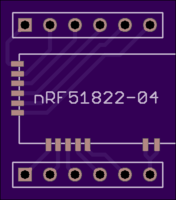nRF5 action!
-
Good news! I went back and re-rechecked using an un-modified Ebyte module, and, indeed, this time I'm sure that the DCDC inductors are already on it! What follows is the proof. Here is the current drawn when the above DCDCEN is enabled on an unmodified Ebyte module: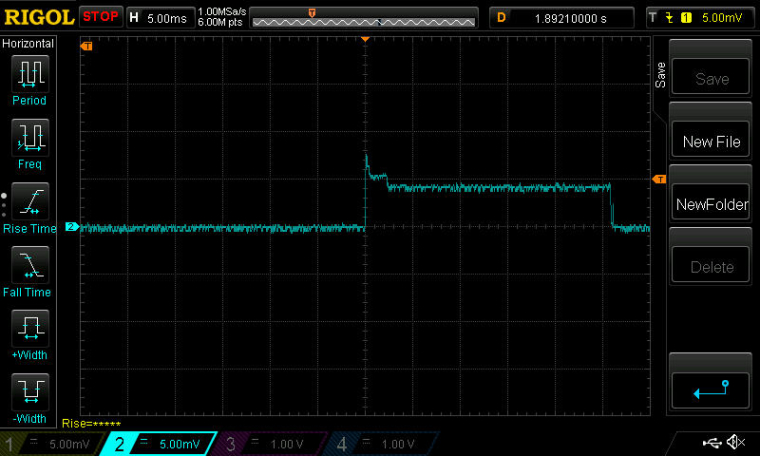
Now, here is the current drawn with the exact same script on the exact same unmodified Ebyte module, but with the DCDCEN line of code commented out:
QED.
As you can see, the savings in current consumption are considerable with the DCDC enabled![Edit: although looking at it again, the timescale seems way off. Argh. Something still isn't right.] -
Scratch the preceeding post. I redid it more carefully this time, and I believe it confirms that the Ebyte module does not have the two inductors required for DC/DC mode.
Here is the current drawn by an unmodified Ebyte nRF52832 module which is programmed to be receiving for about 1.5ms every 100ms:
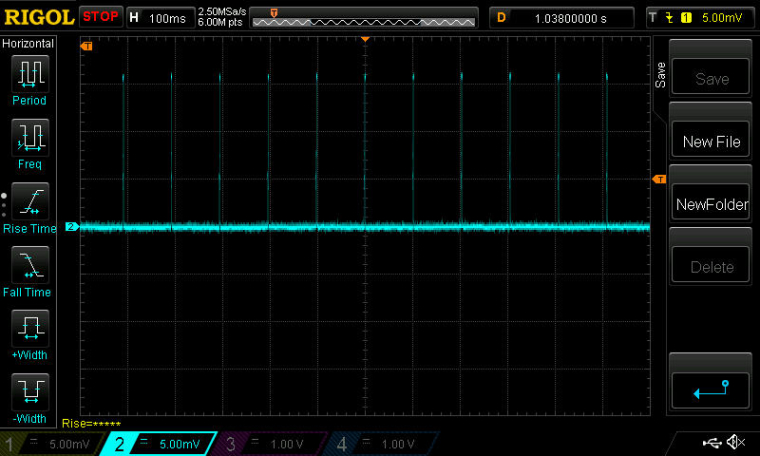

-
Here is what happens with exactly the same hardware (no inductors yet added), but with DCDCEN enabled:
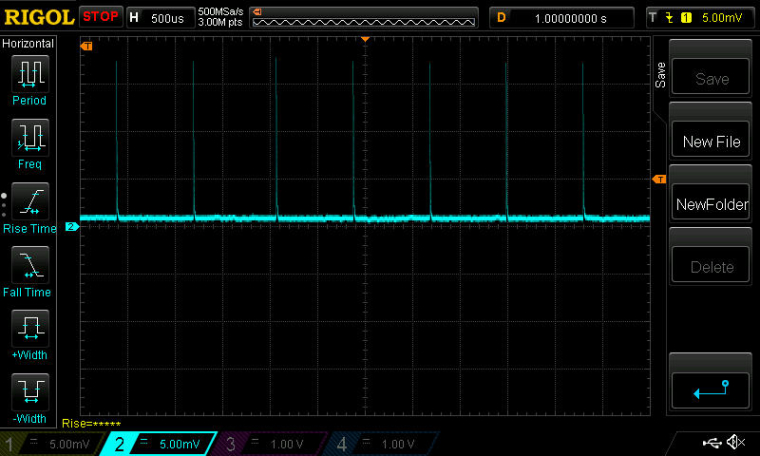

It basically seems caught in a boot loop. -
Now, adding the two inductors between DCC and DEC4, and re-measuring, we get:
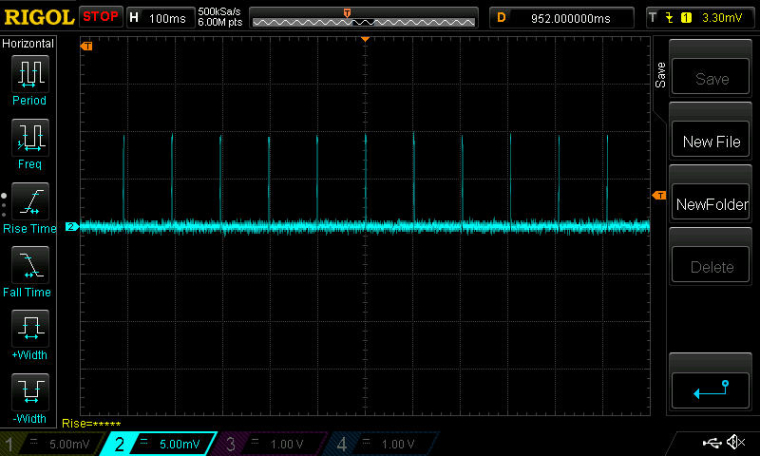
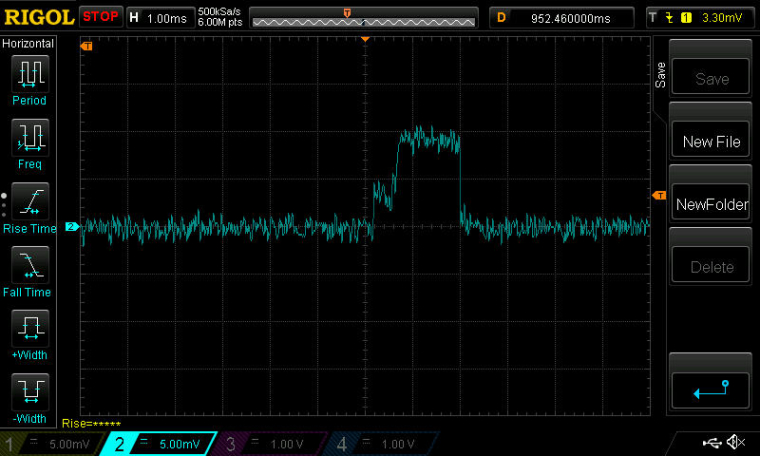
No less importantly, it does receive and decode packets!
Conclusion: Ebyte nRF52832 modules don't come with the DC/DC inductors already installed. However, they can be added, resulting in some current reduction.
-
I've baked these findings into a new breakout board for the Ebyte nRF52832:
https://www.openhardware.io/view/471
The new breakout board will enable the module to work in DC/DC mode. -
I may have found a clue as to why the reset pin (pin0.21) on the nRF52832 isn't working.
On the nRF52832 DK, I read the following register values:
PSELRESET[0]=21
PSELRESET[1]=21which is as expected. However, on the Ebyte nRF52832 module, I read those register values as:
PSELRESET[0]=4294967295
PSELRESET[1]=4294967295which makes no sense. The values match, but they don't correspond to a pin number that can represent RESET.
These two registers are described in the nRF52832 datasheet.
-
I may have found a clue as to why the reset pin (pin0.21) on the nRF52832 isn't working.
On the nRF52832 DK, I read the following register values:
PSELRESET[0]=21
PSELRESET[1]=21which is as expected. However, on the Ebyte nRF52832 module, I read those register values as:
PSELRESET[0]=4294967295
PSELRESET[1]=4294967295which makes no sense. The values match, but they don't correspond to a pin number that can represent RESET.
These two registers are described in the nRF52832 datasheet.
-
@NeverDie not sure if you've already noticed, but 4294967295 is the maximum value for an unsigned 32-bit integer. So the value is 0xFFFFFFFF. That often means uninitialized. I don't know why it would be uninitialized though.
Maybe because they just never were?
Those particular registers are "The user information configuration registers (UICRs) are non-volatile memory (NVM) registers for configuring user specific settings." So, it would seem that initializing them just once would be enough, since they're non-volatile.In any case, good catch! It explains both why they are that value and also why they match.
-
@NeverDie said in nRF5 Bluetooth action!:
4294967295
Also, since 4294967295 equals 0xFFFFFFFF, then bit 31 is a '1', which, according to the datasheet, means the pin is disconnected (see section 14.1.60 PSELRESET[0] of the datasheet for the detail].
-
@NeverDie not sure if you've already noticed, but 4294967295 is the maximum value for an unsigned 32-bit integer. So the value is 0xFFFFFFFF. That often means uninitialized. I don't know why it would be uninitialized though.
@mfalkvidd said in nRF5 Bluetooth action!:
So the value is 0xFFFFFFFF. That often means uninitialized. I don't know why it would be uninitialized though.
There's a chance we may have unwittingly done it ourselves! Remember back to when we were doing an explicit "Erase All"? From the datasheet:
11.5 Erase all
When erase is enabled, the whole Flash and UICR can be erased in one operation by using the ERASEALL
register.Furthermore, from page 29 of the datasheet:
After erasing UICR all bits in UICR are set to '1'.
-
@mfalkvidd said in nRF5 Bluetooth action!:
So the value is 0xFFFFFFFF. That often means uninitialized. I don't know why it would be uninitialized though.
There's a chance we may have unwittingly done it ourselves! Remember back to when we were doing an explicit "Erase All"? From the datasheet:
11.5 Erase all
When erase is enabled, the whole Flash and UICR can be erased in one operation by using the ERASEALL
register.Furthermore, from page 29 of the datasheet:
After erasing UICR all bits in UICR are set to '1'.
@NeverDie said in nRF5 Bluetooth action!:
@mfalkvidd said in nRF5 Bluetooth action!:
So the value is 0xFFFFFFFF. That often means uninitialized. I don't know why it would be uninitialized though.
There's a chance we may have unwittingly done it ourselves! Remember back to when we were doing an explicit "Erase All"? From the datasheet:
This is part of the arduino-nrf5 code -> https://github.com/sandeepmistry/arduino-nRF5/blob/dc53980c8bac27898fca90d8ecb268e11111edc1/cores/nRF5/SDK/components/toolchain/system_nrf52.c#L156
I don't have any idea why this is not included in the binary. When the reset menu is selected then "-DCONFIG_GPIO_AS_PINRESET" is given to gcc.
When system_nrf52.c is completely ignored, then the erratas are not handled.
-
Here is some verbose code which properly sets the registers to use pin P0.21 as the RESET pin:
Serial.println("Testing..."); delay(10000); //give preparation time to open serial tty Serial.print(counter); Serial.print(", PSELRESET[0]="); Serial.println(NRF_UICR-> PSELRESET[0]); Serial.print(counter++); Serial.print(", PSELRESET[1]="); Serial.println(NRF_UICR-> PSELRESET[1]); Serial.println(); Serial.println("Write-enabling CONFIG."); NRF_NVMC->CONFIG=1; // Write enable the UICR Serial.println(); Serial.println("Now designating pin pO.21 as the RESET pin."); NRF_UICR-> PSELRESET[0]=21; //designate pin pO.21 as the RESET pin NRF_UICR-> PSELRESET[1]=21; //designate pin pO.21 as the RESET pin Serial.println(); Serial.println("Confirming that RESET pin assigment took hold:"); Serial.print(counter); Serial.print(", PSELRESET[0]="); Serial.println(NRF_UICR-> PSELRESET[0]); Serial.print(counter++); Serial.print(", PSELRESET[1]="); Serial.println(NRF_UICR-> PSELRESET[1]); Serial.println(); Serial.println("Return CONFIG to read-only mode."); NRF_NVMC->CONFIG=0; // Put the UICR back into read-only mode.Running it once seems to be good enough, unless there were to occur another "Erase All" or "Burn bootloader" event.
Here is the output from running the code which shows that it succeeded:
Testing... 0, PSELRESET[0]=4294967295 0, PSELRESET[1]=4294967295 Write-enabling CONFIG. Now designating pin pO.21 as the RESET pin. Confirming that RESET pin assigment took hold: 1, PSELRESET[0]=21 1, PSELRESET[1]=21 Return CONFIG to read-only mode. -
Until a more elegant solution can be found, I'm using this in the setup() routine as the workaround:
if (((NRF_UICR-> PSELRESET[0])==0xFFFFFFFF) && ((NRF_UICR-> PSELRESET[1])==0xFFFFFFFF)) { //if the two RESET registers are erased NRF_NVMC->CONFIG=1; // Write enable the UICR NRF_UICR-> PSELRESET[0]=21; //designate pin P0.21 as the RESET pin NRF_UICR-> PSELRESET[1]=21; //designate pin P0.21 as the RESET pin NRF_NVMC->CONFIG=0; // Put the UICR back into read-only mode. }The code has the positive virtue of not writing to the RESET rregisters unless both registers are erased. That helps ensure that the non-volatile memory does not get worn out prematurely.
-
Until a more elegant solution can be found, I'm using this in the setup() routine as the workaround:
if (((NRF_UICR-> PSELRESET[0])==0xFFFFFFFF) && ((NRF_UICR-> PSELRESET[1])==0xFFFFFFFF)) { //if the two RESET registers are erased NRF_NVMC->CONFIG=1; // Write enable the UICR NRF_UICR-> PSELRESET[0]=21; //designate pin P0.21 as the RESET pin NRF_UICR-> PSELRESET[1]=21; //designate pin P0.21 as the RESET pin NRF_NVMC->CONFIG=0; // Put the UICR back into read-only mode. }The code has the positive virtue of not writing to the RESET rregisters unless both registers are erased. That helps ensure that the non-volatile memory does not get worn out prematurely.
@NeverDie said in nRF5 Bluetooth action!:
Until a more elegant solution can be found, I'm using this in the setup() routine as the workaround:
if (((NRF_UICR-> PSELRESET[0])==0xFFFFFFFF) && ((NRF_UICR-> PSELRESET[1])==0xFFFFFFFF)) { //if the two RESET registers are erased NRF_NVMC->CONFIG=1; // Write enable the UICR NRF_UICR-> PSELRESET[0]=21; //designate pin P0.21 as the RESET pin NRF_UICR-> PSELRESET[1]=21; //designate pin P0.21 as the RESET pin NRF_NVMC->CONFIG=0; // Put the UICR back into read-only mode. }The code has the positive virtue of not writing to the RESET rregisters unless both registers are erased. That helps ensure that the non-volatile memory does not get worn out prematurely.
Good news! I've confirmed that doing this does indeed solve the problem I previously had with the EByte nRF52832 module not reacting to a reset on pin P0.21. After inserting the above code block into the nRF52832's setup() routine, I can now, using ESP-LINK, remotely reset an nRF52832 module:
https://www.openhardware.io/view/443/nRF52832-ESP-LINK-Shield-for-ESP8266-Wemos-D1-Mini -
With that issue now settled, I'm moving on to a different topic: what happens if you put the radio into Tx mode, but with an empty buffer (i.e. nothing to send)? In this scenario an RFM69 transmits a continuous pre-amble, and I'm wondering whether the nRF52832 does the same?
With an empty buffer, does it transmit anything at all? Anyone happen to know?The reason I ask is that I want to program the radio to send a continuous signal so as to quickly wake-up a receiver. With packets, there's the lag time of receiving and decoding the packet, rather than just reacting to a high RSSI. In this way, I can use much narrower listen windows and thereby save a lot of current consumption.
-
According to the datasheet, the typical RSSI sample period is just 0.25us. However, what spoils that a bit is that the radio has to come up to speed beforehand.
Anyhow, on the receive side, I now have at least that much working.
-
It looks as though the start-up time for the radio is about 390us. So, it does save a lot of current to first check the RSSI level rather than to always listen for a packet.
-
When I measure RSSI on the nRF52832, I get what seems like a rather odd range of values: between about 94 and 127. If I have no other nodes transmitting, then the RSSI is generally around 100. If I set up another node which deliberately transmits on the same channel, then the RSSI is pegged at 127.
Is that what others here are also seeing? Here's the test code:
uint8_t theRSSI; void loop() { NRF_RADIO->TASKS_RXEN=1; //start revving up the receiver while (!(NRF_RADIO->EVENTS_READY)) {} //busy-wait until radio ready to receive NRF_RADIO->TASKS_RSSISTART=1; //Take exactly one RSSI sample while (!(NRF_RADIO->EVENTS_RSSIEND)) {} //Busy-wait until RSSI sample is completed. theRSSI = NRF_RADIO->RSSISAMPLE; Serial.println(theRSSI); Serial.flush(); sleep(1000); } -
Unfortunately, when I use the above code block and test the current using an oscilliscope, it becomes clear that the radio never actually goes to sleep:
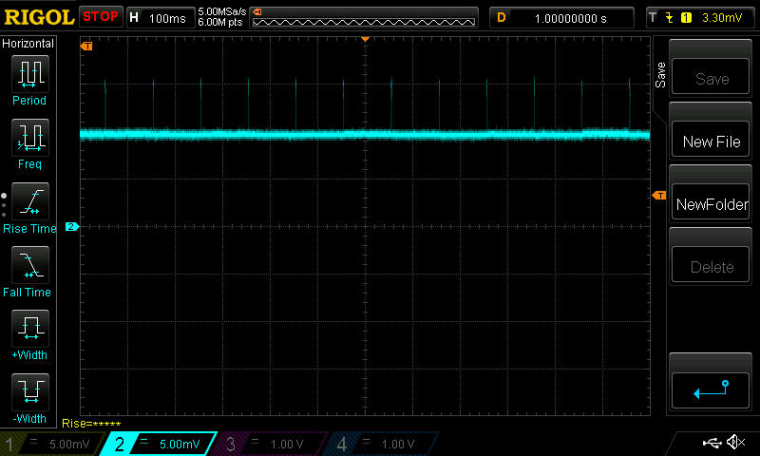
So, to do that, I add the line:NRF_RADIO->TASKS_DISABLE=1; //turn-off the radiojust prior to sleep(100). Doing that largely eliminates the current drain while sleeping:
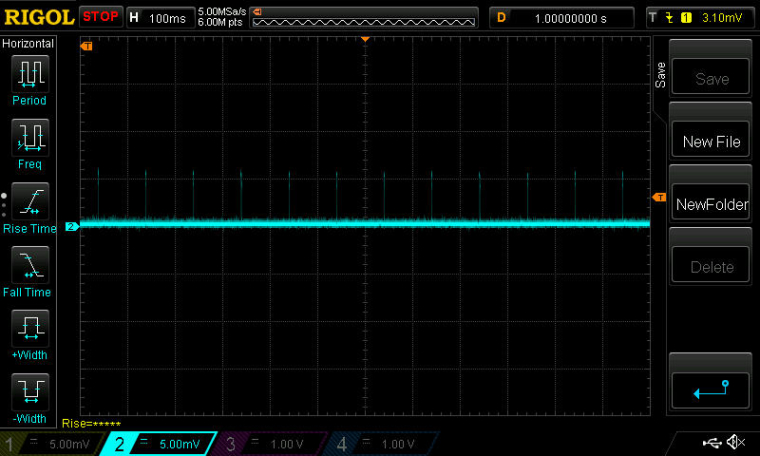
However, if I do that, then the RSSI that gets reported is always 127. Why? Do I need some other way to check the radio states? Maybe STATE from section 23.14.25 STATE of the datasheet would work better?
-
Found a breakout board for the nRF51822-04: https://oshpark.com/shared_projects/zqDQaykJ
